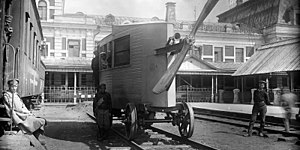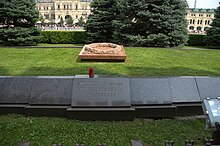Aerowagon
| Аэроваго́н | |
|---|---|
 Abakovsky's Aerowagon (Front View) | |
| Manufacturer | Valerian Ivanovich Abakovsky |
| Built at | Russian SFSR |
| Constructed | 1917 |
| Scrapped | 1921 (destroyed) |
| Number built | 1 |
| Specifications | |
| Maximum speed | 140 kilometres per hour (87 mph) |
| Prime mover(s) | Aircraft engine |
The Aerowagon or Aeromotowagon (Russian: Аэроваго́н, аэродрези́на, romanized: aerovagon, aerodrezyna) was an experimental high-speed railcar fitted with an aircraft engine and propeller traction invented by Valerian Abakovsky, a Soviet engineer from Latvia. It produced speeds of up to 140 kilometres per hour (87 miles per hour).[1] The Aerowagon was originally intended for the express transportation of important documents and to carry Soviet officials on government business.[2]
Crash incident
[edit]On 24 July 1921, a group of delegates to the First Congress of the Profintern,[3] led by Fyodor Sergeyev, took the Aerowagon from Moscow to the Tula collieries to meet with local miners and to visit an arms factory.[2][4] Abakovsky was also on board. Although they successfully arrived in Tula, on the return route to Moscow the Aerowagon derailed at high speed near Serpukhov,[3][5] killing six of the 22 people on board.[2] A seventh man (Paul Freeman) later died of his injuries.[6][7]
An official investigation concluded that the cause of the derailment was the poor condition of the railway track. Artyom Sergeyev (the son of victim Fyodor Sergeyev) claimed sabotage arranged by Trotsky.[5][8][9]
Deaths
[edit]The following people died as a result of the accident:[10]
- Ivan Konstantinov [ru], Bulgarian delegate
- Paul Freeman, Australian delegate
- Oskar Hellbrück, German delegate
- William James Hewlett, British delegate
- Fyodor Sergeyev (known as "Comrade Artyom")
- Otto Strupat, German delegate
- Valerian Abakovsky, the Aerowagon's inventor

All seven men lay in state at the House of the Unions, after which they were buried with honors in the Kremlin Wall Necropolis.[6][11] Sergeyev is buried in Mass Grave No. 12, Konstantinov, Abakovsky and Freeman are buried in Mass Grave No. 13, while Strupat, Helbrich and Hewlett are buried in Mass Grave No. 14.
Legacy
[edit]
The Aerowagon was a precursor to the German Schienenzeppelin railcar, the American M-497 Black Beetle railcar and the Soviet turbojet train, all three of them being experimental vehicles featuring the combination of railcar and aircraft engines.
See also
[edit]References
[edit]- ^ "По рельсам c…пропеллером". MK.ru (in Russian). 10 August 2007. Archived from the original on 23 August 2011.
- ^ a b c Ishkov, Sergey (24 July 2019). "Последний «полет» аэровагона". Moskovskaya Pravda (in Russian).
- ^ a b The Communist International, organ of the Executive Committee of the Communist International, no.19, [1921]
- ^ Sinelshchikova, Ekaterina (4 August 2021). "Первый советский Аэровагон и что с ним случилось". Russia Beyond (in Russian).
- ^ a b Ovchinnikov, Dmitry (24 July 2021). "Товарищ Артём. Смерть в аэровагоне". Rodina (in Russian).
- ^ a b Letters from Tom Mann to Elsie Mann, Moscow, 26 and 30 July 1921; archives of Tom Mann, Modern Records Centre, University of Warwick, document references: MSS.334/3/6/5-6.
- ^ "The Story of Freeman and Sergaeff". The Workers' Weekly. 30 July 1926. p. 4.
- ^ Dmitrievsky, Alexander (2007). "Для меня большая честь – быть сыном председателя Донецко-Криворожской Республики" (in Russian). Донецкий коммуникационный ресурс. Archived from the original on 9 December 2013.
- ^ YEKATERINA SINELSCHIKOVA (3 August 2021). "USSR's first AEROWAGON - and the dark story behind it". Russia Beyond. Retrieved 7 June 2023.
- ^ Windle, Kevin (2004). "Brisbane Prison: Artem Sergeev Describes Boggo Road". New Zealand Slavonic Journal. 38: 160, 177. JSTOR 40922184.
- ^ "КРАСНАЯ ПЛОЩАДЬ - это... Что такое КРАСНАЯ ПЛОЩАДЬ?". academic.ru. Retrieved 29 November 2017.
Bibliography
[edit]- Alexey Abramov / Алексей Абрамов, By the Kremlin Wall / У кремлёвской стены, Moscow / Москва́, Politizdat / Политиздат, 1978, pp./стр. 399 (in Russian)
